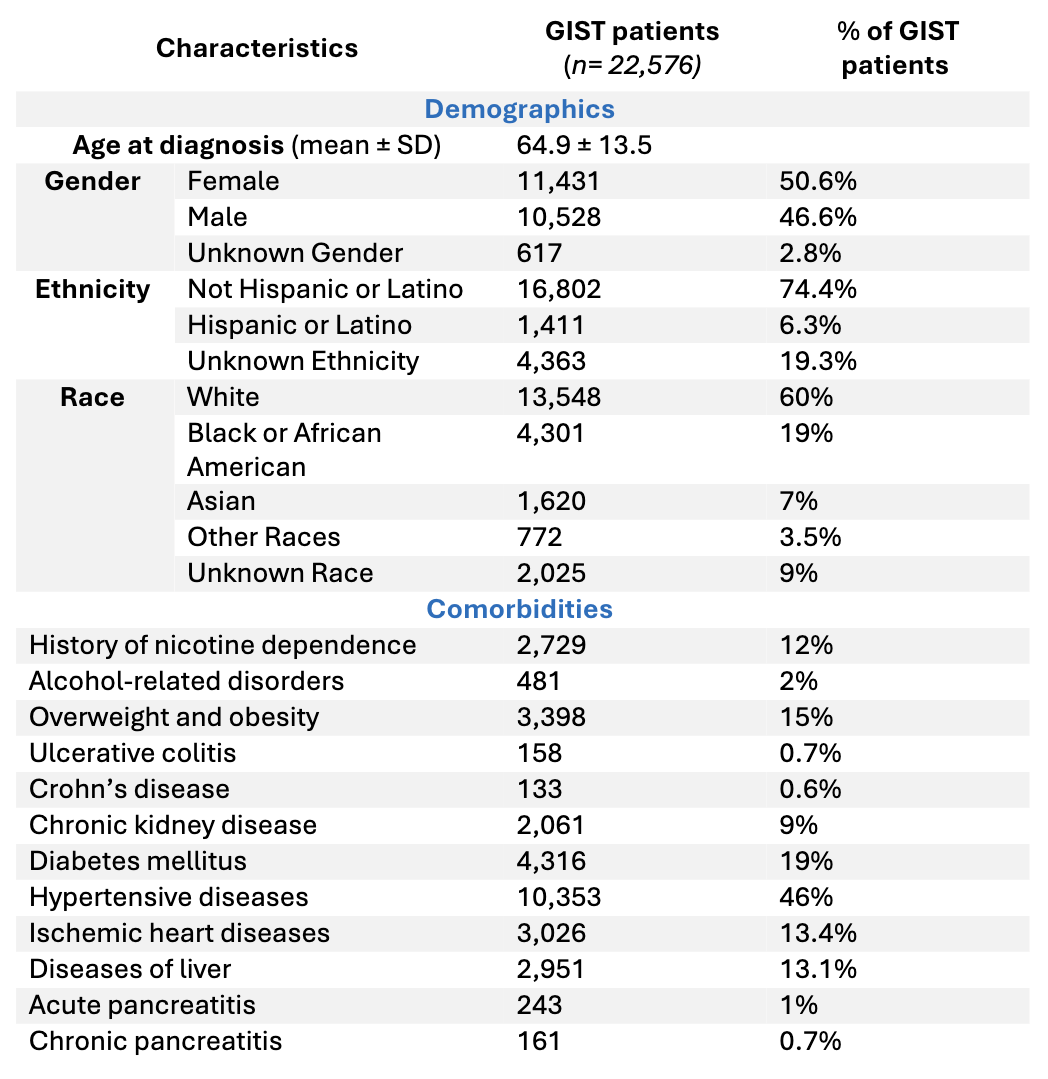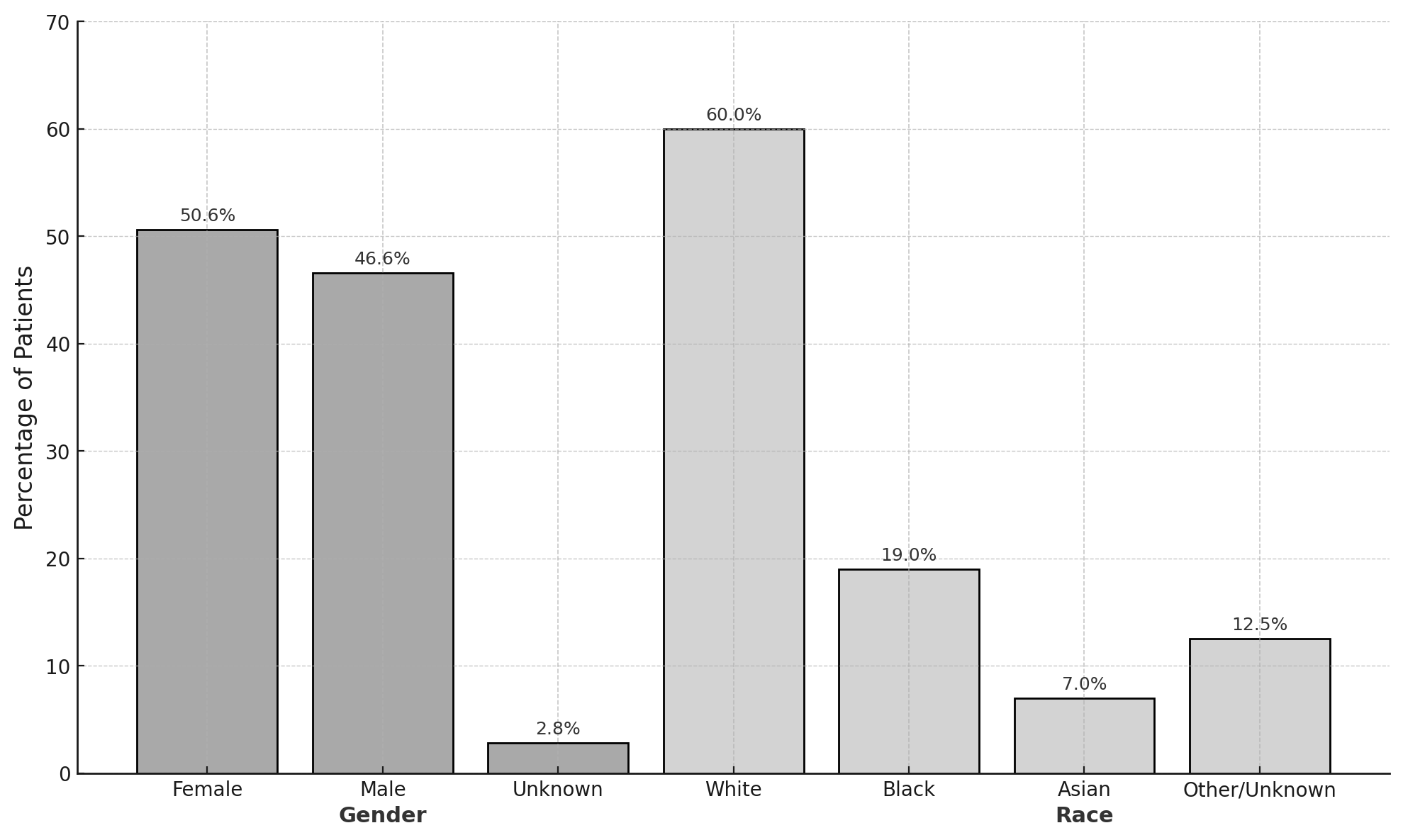Monday Poster Session
Category: Small Intestine
P4057 - Epidemiology and Baseline Characteristics of Patients With Gastrointestinal Stromal Tumors: A Population-Based Study in the United States
Monday, October 27, 2025
10:30 AM - 4:00 PM PDT
Location: Exhibit Hall

Omar Abureesh, MD (he/him/his)
Staten Island University Hospital, Northwell Health
Staten Island, NY
Presenting Author(s)
Omar Abureesh, MD1, Mohammed Aloqaily, MD2, Ahmad Abdulraheem, MD3, Pinghsin Hsieh, MD4, Zaid Khamis, MD1, Ahmad Alomari, MD5, Youssef El Douaihy, MD1, Jean Chalhoub, MD1, Sherif Andrawes, MD1
1Staten Island University Hospital, Northwell Health, Staten Island, NY; 2University of Maryland Medical Center Midtown Campus, Baltimore, MD; 3MedStar Washington Hospital Center-Georgetown University, Washington, DC; 4University of Maryland Medical Center midtown campus, Baltimore, MD; 5Henry Ford Health, Detroit, MI
Introduction: Gastrointestinal stromal tumors (GISTs) are the most common mesenchymal cancer of the gastrointestinal tract (GIT), with a peak incidence at the age of 60-74 years. Their overall global incidence has been estimated as 10-20 per million, accounting for approximately 1–2% of the total GIT malignancies. Understanding the baseline demographics and comorbidities of GISTs can enhance early recognition, risk stratification, and management.
Methods: We conducted a retrospective descriptive study using TriNetX, a global database of de-identified electronic patients' health records. Adults aged 18 years and older with a confirmed diagnosis of gastrointestinal stromal tumor (GIST), identified by ICD-10 code (C49.A), between October 2015 and May 2025, were included. Demographics (age, sex, race, ethnicity) and baseline comorbidities were analysed.
Results: Our data showed that out of 153,382,260 patients screened in TriNetX, 22,576 individuals had a diagnosis of GIST with overall prevalence of 15 cases per 100,000 and a mean age of 64.9 years (±13.5) at diagnosis, females comprised 50.6% of the sample. Racially, 60% of our sample were White, 19% were Black or African American, 7% Asian, and 3.5% from other races, with 9% unspecified. The demographic composition of our sample is shown in Figure 1.
Common comorbidities were analysed including hypertensive diseases (46%), diabetes mellitus (19%), and ischemic heart diseases (13.4%). Obesity or overweight status was recorded in 15%, liver disease in 13.1%, and nicotine dependence in 12%. Chronic kidney disease affected 9% of patients. Less common but potentially relevant comorbidities was analysed in our study such as alcohol-related disorders (2%), ulcerative colitis (0.7%), Crohn’s disease (0.6%), acute pancreatitis (1%) and chronic pancreatitis (0.7%). Baseline characteristics are shown in Table 1.
Discussion: In this large U.S. GIST sample, age and gender composition matched the existing data in the literature suggesting no significant gender predominance and a mean age at diagnosis of >60. Additionally, as reported by previously established data, our study shows that cardiometabolic comorbidities are frequently co-reported in GIST patients. These findings reinforce the importance of holistic risk stratification strategies and further epidemiologic monitoring for GIST cases.

Figure: Figure 1: Demographic composition of patients with GIST.

Figure: Table 1: Baseline characteristics of patients diagnosed with GIST.
Disclosures:
Omar Abureesh indicated no relevant financial relationships.
Mohammed Aloqaily indicated no relevant financial relationships.
Ahmad Abdulraheem indicated no relevant financial relationships.
Pinghsin Hsieh indicated no relevant financial relationships.
Zaid Khamis indicated no relevant financial relationships.
Ahmad Alomari indicated no relevant financial relationships.
Youssef El Douaihy indicated no relevant financial relationships.
Jean Chalhoub indicated no relevant financial relationships.
Sherif Andrawes indicated no relevant financial relationships.
Omar Abureesh, MD1, Mohammed Aloqaily, MD2, Ahmad Abdulraheem, MD3, Pinghsin Hsieh, MD4, Zaid Khamis, MD1, Ahmad Alomari, MD5, Youssef El Douaihy, MD1, Jean Chalhoub, MD1, Sherif Andrawes, MD1. P4057 - Epidemiology and Baseline Characteristics of Patients With Gastrointestinal Stromal Tumors: A Population-Based Study in the United States, ACG 2025 Annual Scientific Meeting Abstracts. Phoenix, AZ: American College of Gastroenterology.
1Staten Island University Hospital, Northwell Health, Staten Island, NY; 2University of Maryland Medical Center Midtown Campus, Baltimore, MD; 3MedStar Washington Hospital Center-Georgetown University, Washington, DC; 4University of Maryland Medical Center midtown campus, Baltimore, MD; 5Henry Ford Health, Detroit, MI
Introduction: Gastrointestinal stromal tumors (GISTs) are the most common mesenchymal cancer of the gastrointestinal tract (GIT), with a peak incidence at the age of 60-74 years. Their overall global incidence has been estimated as 10-20 per million, accounting for approximately 1–2% of the total GIT malignancies. Understanding the baseline demographics and comorbidities of GISTs can enhance early recognition, risk stratification, and management.
Methods: We conducted a retrospective descriptive study using TriNetX, a global database of de-identified electronic patients' health records. Adults aged 18 years and older with a confirmed diagnosis of gastrointestinal stromal tumor (GIST), identified by ICD-10 code (C49.A), between October 2015 and May 2025, were included. Demographics (age, sex, race, ethnicity) and baseline comorbidities were analysed.
Results: Our data showed that out of 153,382,260 patients screened in TriNetX, 22,576 individuals had a diagnosis of GIST with overall prevalence of 15 cases per 100,000 and a mean age of 64.9 years (±13.5) at diagnosis, females comprised 50.6% of the sample. Racially, 60% of our sample were White, 19% were Black or African American, 7% Asian, and 3.5% from other races, with 9% unspecified. The demographic composition of our sample is shown in Figure 1.
Common comorbidities were analysed including hypertensive diseases (46%), diabetes mellitus (19%), and ischemic heart diseases (13.4%). Obesity or overweight status was recorded in 15%, liver disease in 13.1%, and nicotine dependence in 12%. Chronic kidney disease affected 9% of patients. Less common but potentially relevant comorbidities was analysed in our study such as alcohol-related disorders (2%), ulcerative colitis (0.7%), Crohn’s disease (0.6%), acute pancreatitis (1%) and chronic pancreatitis (0.7%). Baseline characteristics are shown in Table 1.
Discussion: In this large U.S. GIST sample, age and gender composition matched the existing data in the literature suggesting no significant gender predominance and a mean age at diagnosis of >60. Additionally, as reported by previously established data, our study shows that cardiometabolic comorbidities are frequently co-reported in GIST patients. These findings reinforce the importance of holistic risk stratification strategies and further epidemiologic monitoring for GIST cases.

Figure: Figure 1: Demographic composition of patients with GIST.

Figure: Table 1: Baseline characteristics of patients diagnosed with GIST.
Disclosures:
Omar Abureesh indicated no relevant financial relationships.
Mohammed Aloqaily indicated no relevant financial relationships.
Ahmad Abdulraheem indicated no relevant financial relationships.
Pinghsin Hsieh indicated no relevant financial relationships.
Zaid Khamis indicated no relevant financial relationships.
Ahmad Alomari indicated no relevant financial relationships.
Youssef El Douaihy indicated no relevant financial relationships.
Jean Chalhoub indicated no relevant financial relationships.
Sherif Andrawes indicated no relevant financial relationships.
Omar Abureesh, MD1, Mohammed Aloqaily, MD2, Ahmad Abdulraheem, MD3, Pinghsin Hsieh, MD4, Zaid Khamis, MD1, Ahmad Alomari, MD5, Youssef El Douaihy, MD1, Jean Chalhoub, MD1, Sherif Andrawes, MD1. P4057 - Epidemiology and Baseline Characteristics of Patients With Gastrointestinal Stromal Tumors: A Population-Based Study in the United States, ACG 2025 Annual Scientific Meeting Abstracts. Phoenix, AZ: American College of Gastroenterology.
